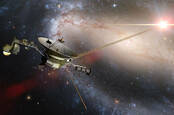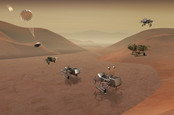This article is more than 1 year old
Eight-hour comms lags and shock discoveries: 30 years after Voyager 2 visited gas giant Neptune
That time we found those lovely old geysers on one of the icy giant's MOONS
As the world took down the bunting from the Apollo 11 celebrations, another anniversary rolled around: this weekend marked 30 years since Voyager 2 had its final planetary encounter, with Neptune.
The closest approach of the giant by the long-lived probe occurred on 25 August 1989 and represented humanity's first, and only, close-up look at the eighth, and farthest, planet in the Solar System.
I will never forget the Voyager encounter party at JPL with Chuck Berry and his rendition of 'Johnny B. Goode' – the sound that inhabitants of another star will hear as the Voyager spacecraft approach...
The mission was originally intended only to visit Jupiter and Saturn - indeed it was originally titled Mariner Jupiter Saturn (MJS) - canny engineers had brimmed the tanks of the Voyager probes with an eye to being able to keep going, should the powers that be elect to keep funding running.
Which, of course, it did, as the Voyager mission was extended to take in Uranus and, 30 years ago, Neptune.
That fuel was handy, because shortly before the encounter with Neptune, the trajectory of the spacecraft required tweaking. And, of course, the speed of the spacecraft (about 90,000 kph relative to Earth) meant more work was needed to ensure the camera platform moved at the correct rate in order to avoid any blurring of the precious images.
Oh, and being that far out from the Sun meant that there was only about 0.001 times the amount of sunlight received by Earth. Those cameras would also need longer exposures.
Eight-hour comms lags
That it worked at all was achievement enough. On top of that, the science gleaned from those images vastly increased humanity's understanding of the ice giant.
A vast "Great Dark Spot" storm was visible in the blue atmosphere of the planet, wrapped in clouds indicating a highly active atmosphere. The probe also spotted six previously undiscovered Moons and four new rings.
Anxious to make the most of the fleeting visit, the team also had the probe perform a flyby of Neptune's largest moon, Triton, which, rather than revealing a ball of ice, showed an active surface peppered with geysers, despite having a surface temperature of -235˚C.
"Every day," said Ed Stone, a professor of physics at Caltech and Voyager's project scientist since 1975, "we learned something new."
Dr Garry Hunt, one of the original imaging team members, told The Register that being at JPL during the encounter "was an incredible experience," noting that communication times were eight hours each way because of the vast distances involved.
Hunt struggled to pick individual highlights from the "countless number" of scientific results, but listed that "discovery of a very active atmosphere with the fastest winds in the solar system" as one, which the team derived from tracking the equatorial cloud system visible in the images.
He also noted that the cloud system was not a permanent feature and told us that during monitoring thanks to the Hubble Space Telescope the feature disappeared, with another cloud system replacing it.
As with the discoveries of the moons of earlier encounters, Hunt told us "the active geology on the satellites was a complete surprise." He went on to tell us: "Only impact craters were expected. Miranda [was surprising because of] the unexpected evidence of tectonic activity, and Triton, with even more unexpected evidence of nitrogen geysers."
Perhaps a little wistfully, he added: "But so little of the satellite surfaces has been seen. Who knows the further mysteries that may be waiting future close up observations in the future?"
Voyager 2 remains the only spacecraft to have visited the ice giant.
As for the atmosphere at JPL 30 years ago, Hunt, who also provided daily real-time links for ITN news broadcasts, recalled: "I will never forget the Voyager encounter party at JPL with Chuck Berry and his rendition of 'Johnny B. Goode' – the sound that inhabitants of another star will hear as the Voyager spacecraft approach!"
And, of course, Berry's hit is preserved on the Voyager golden disc.
To put the mission in context, Hunt also told us: "My elder daughter came to work with me during this encounter. When I wrote my proposal to NASA for this mission, she was five years old; at the time of the encounter she was a PhD student at Cambridge!"
The Neptune encounter also marked the start of Voyager 2's interstellar mission. At the time of the flyby, Voyager 2 was about 4.7 billion kilometres from Earth; today that figure is more like 18 billion kilometres as the spacecraft continues into interstellar space. ®


